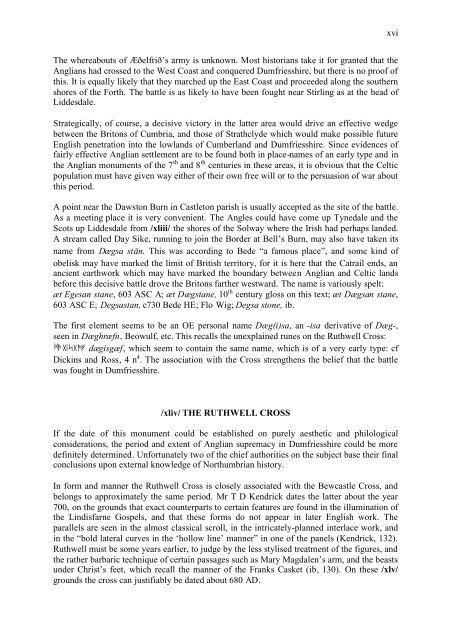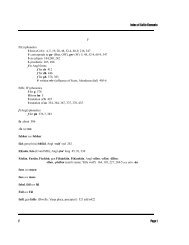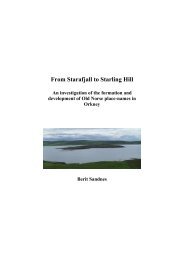May Williamson: The Non-Celtic Place-Names of the Scottish Border ...
May Williamson: The Non-Celtic Place-Names of the Scottish Border ...
May Williamson: The Non-Celtic Place-Names of the Scottish Border ...
Create successful ePaper yourself
Turn your PDF publications into a flip-book with our unique Google optimized e-Paper software.
xvi<br />
<strong>The</strong> whereabouts <strong>of</strong> Æðelfrið’s army is unknown. Most historians take it for granted that <strong>the</strong><br />
Anglians had crossed to <strong>the</strong> West Coast and conquered Dumfriesshire, but <strong>the</strong>re is no pro<strong>of</strong> <strong>of</strong><br />
this. It is equally likely that <strong>the</strong>y marched up <strong>the</strong> East Coast and proceeded along <strong>the</strong> sou<strong>the</strong>rn<br />
shores <strong>of</strong> <strong>the</strong> Forth. <strong>The</strong> battle is as likely to have been fought near Stirling as at <strong>the</strong> head <strong>of</strong><br />
Liddesdale.<br />
Strategically, <strong>of</strong> course, a decisive victory in <strong>the</strong> latter area would drive an effective wedge<br />
between <strong>the</strong> Britons <strong>of</strong> Cumbria, and those <strong>of</strong> Strathclyde which would make possible future<br />
English penetration into <strong>the</strong> lowlands <strong>of</strong> Cumberland and Dumfriesshire. Since evidences <strong>of</strong><br />
fairly effective Anglian settlement are to be found both in place-names <strong>of</strong> an early type and in<br />
<strong>the</strong> Anglian monuments <strong>of</strong> <strong>the</strong> 7 th and 8 th centuries in <strong>the</strong>se areas, it is obvious that <strong>the</strong> <strong>Celtic</strong><br />
population must have given way ei<strong>the</strong>r <strong>of</strong> <strong>the</strong>ir own free will or to <strong>the</strong> persuasion <strong>of</strong> war about<br />
this period.<br />
A point near <strong>the</strong> Dawston Burn in Castleton parish is usually accepted as <strong>the</strong> site <strong>of</strong> <strong>the</strong> battle.<br />
As a meeting place it is very convenient. <strong>The</strong> Angles could have come up Tynedale and <strong>the</strong><br />
Scots up Liddesdale from /xliii/ <strong>the</strong> shores <strong>of</strong> <strong>the</strong> Solway where <strong>the</strong> Irish had perhaps landed.<br />
A stream called Day Sike, running to join <strong>the</strong> <strong>Border</strong> at Bell’s Burn, may also have taken its<br />
name from Dægsa stn. This was according to Bede “a famous place”, and some kind <strong>of</strong><br />
obelisk may have marked <strong>the</strong> limit <strong>of</strong> British territory, for it is here that <strong>the</strong> Catrail ends, an<br />
ancient earthwork which may have marked <strong>the</strong> boundary between Anglian and <strong>Celtic</strong> lands<br />
before this decisive battle drove <strong>the</strong> Britons far<strong>the</strong>r westward. <strong>The</strong> name is variously spelt:<br />
æt Egesan stane, 603 ASC A; æt Dægstane, 10 th century gloss on this text; æt Dægsan stane,<br />
603 ASC E; Degsastan, c730 Bede HE; Flo Wig; Degsa stone, ib.<br />
<strong>The</strong> first element seems to be an OE personal name Dæg(i)sa, an -isa derivative <strong>of</strong> Dæg-,<br />
seen in Dæghræfn, Beowulf, etc. This recalls <strong>the</strong> unexplained runes on <strong>the</strong> Ruthwell Cross:<br />
ᚫᚷᛁᛋᚷᚫᚠdægisgæf, which seem to contain <strong>the</strong> same name, which is <strong>of</strong> a very early type: cf<br />
Dickins and Ross, 4 n 4 . <strong>The</strong> association with <strong>the</strong> Cross streng<strong>the</strong>ns <strong>the</strong> belief that <strong>the</strong> battle<br />
was fought in Dumfriesshire.<br />
/xliv/ THE RUTHWELL CROSS<br />
If <strong>the</strong> date <strong>of</strong> this monument could be established on purely aes<strong>the</strong>tic and philological<br />
considerations, <strong>the</strong> period and extent <strong>of</strong> Anglian supremacy in Dumfriesshire could be more<br />
definitely determined. Unfortunately two <strong>of</strong> <strong>the</strong> chief authorities on <strong>the</strong> subject base <strong>the</strong>ir final<br />
conclusions upon external knowledge <strong>of</strong> Northumbrian history.<br />
In form and manner <strong>the</strong> Ruthwell Cross is closely associated with <strong>the</strong> Bewcastle Cross, and<br />
belongs to approximately <strong>the</strong> same period. Mr T D Kendrick dates <strong>the</strong> latter about <strong>the</strong> year<br />
700, on <strong>the</strong> grounds that exact counterparts to certain features are found in <strong>the</strong> illumination <strong>of</strong><br />
<strong>the</strong> Lindisfarne Gospels, and that <strong>the</strong>se forms do not appear in later English work. <strong>The</strong><br />
parallels are seen in <strong>the</strong> almost classical scroll, in <strong>the</strong> intricately-planned interlace work, and<br />
in <strong>the</strong> “bold lateral curves in <strong>the</strong> ‘hollow line’ manner” in one <strong>of</strong> <strong>the</strong> panels (Kendrick, 132).<br />
Ruthwell must be some years earlier, to judge by <strong>the</strong> less stylised treatment <strong>of</strong> <strong>the</strong> figures, and<br />
<strong>the</strong> ra<strong>the</strong>r barbaric technique <strong>of</strong> certain passages such as Mary Magdalen’s arm, and <strong>the</strong> beasts<br />
under Christ’s feet, which recall <strong>the</strong> manner <strong>of</strong> <strong>the</strong> Franks Casket (ib, 130). On <strong>the</strong>se /xlv/<br />
grounds <strong>the</strong> cross can justifiably be dated about 680 AD.




